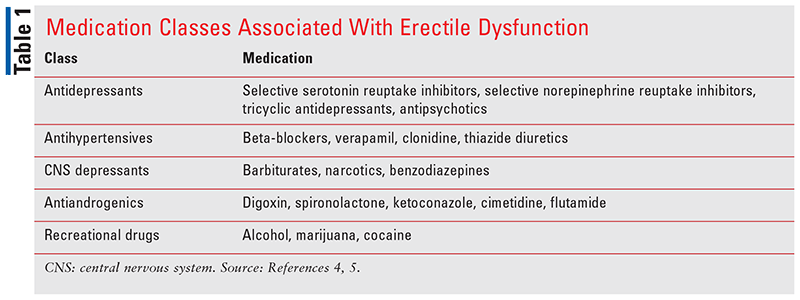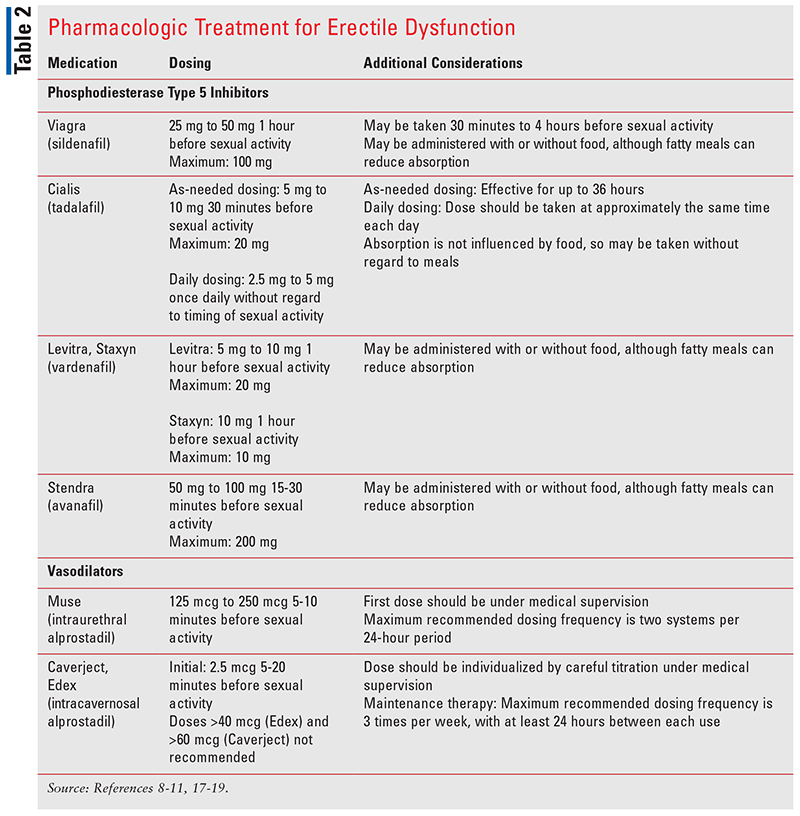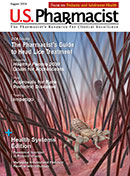US Pharm. 2022;47(6):18-22.
ABSTRACT: Erectile dysfunction (ED) is a common urologic condition that causes distress in men. Risk factors and predictors for ED include age, cardiovascular disease (CVD), hypertension, diabetes, smoking, and certain medications. CVD and ED share several risk factors, and ED may be a predictor of future cardiovascular events. Lifestyle modifications and phosphodiesterase type 5 inhibitors (PDE5Is) are considered first-line therapies for ED. PDE5Is can be less effective in patients with diabetes and should be used cautiously in certain patients with CVD. This review explores treatment options for ED with a focus on those with a history of diabetes or CVD.
Erectile dysfunction (ED), formerly termed impotence, is defined as the persistent inability to develop or maintain a penile erection allowing for satisfactory sexual performance.1 ED is an important public health problem and can cause serious distress to men, particularly affecting their masculinity and self-esteem.2,3 The Massachusetts Male Aging Study reported an overall prevalence of 52% for any degree of ED and demonstrated that prevalence clearly increases with age.3 For instance, the annual incidence rate reported was 12.4 cases per 1,000 man-years, 29.8 and 46.4 for men aged 40 to 49, 50 to 59, and 60 to 69 years, respectively.3
Penile erection is a complex process that involves the vascular, hormonal, neurologic, and psychological systems.4 In the presence of sexual stimulation, which is mediated by the central nervous system, nitric oxide (NO) is released from nonadrenergic, noncholinergic nerve fibers, resulting in the activation of guanylyl cyclase and an increase in cyclic guanosine monophosphate (cGMP). Additionally, parasympathetic cholinergic nerves release acetylcholine, leading to the activation of adenylyl cyclase, which results in an increase in cyclic adenosine monophosphate levels. These signaling pathways decrease intracellular calcium levels, which leads to smooth-muscle relaxation and increases blood flow into sinusoids of the corpora cavernosa. Subsequently, the subtunical veins become compressed, blocking venous outflow from the corpora, thus maintaining the erection.4
ED can result from an abnormality or combination of abnormalities in one of these four systems.4,5 ED is categorized as organic (i.e., neurogenic, vasculogenic, hormonal), psychogenic, or mixed. Common causes of psychogenic ED include stress, performance anxiety, and depression. Vasculogenic ED is the most common cause of organic ED. Hypertension, atherosclerosis, diabetes, and lifestyle factors (e.g., smoking) can lead to alterations in the vascular flow of the corpora cavernosa and are common risk factors for ED. ED is now considered an underlying manifestation of cardiovascular disease (CVD), and its development often precedes clinical cardiovascular (CV) events. Neurogenic causes of ED include spinal cord injuries, stroke, and multiple sclerosis. Hypogonadism and thyroid disease are considered hormonal causes of ED.4,5
A detailed medical history, sexual history, and physical exam are warranted to identify causative or reversible factors involved in ED.4 Select laboratory tests (e.g., serum testosterone, serum blood glucose, fasting lipid panel, thyroid-stimulating hormone) may be obtained to identify causative factors of ED. Additionally, a detailed medication history is necessary to identify medications that may be contributing to ED (see TABLE 1).4,5

Management of ED
Optimal management of ED involves shared decision-making between the patient, his partner, and the treating clinician.6 Underlying disease states and risk factors should be identified and treated or minimized.5 Contributing medications should be discontinued, or the dose should be reduced.5 A variety of nonpharmacologic and pharmacologic treatment options may be considered for ED treatment. Generally, oral medications are trialed first, and more invasive options are reserved for those who fail to respond to initial therapy.5,6Nonpharmalogic Treatment
Nonpharmacologic treatment of ED includes lifestyle modifications, psychotherapy, use of vacuum erection devices (VEDs), or surgical interventions. Lifestyle interventions include increasing physical activity, weight loss, smoking cessation, and avoidance of excessive alcohol intake.5 Psychotherapy may be beneficial, especially in cases of psychogenic ED.5VEDs are noninvasive devices that are available OTC or by prescription. They are used to generate negative pressure, drawing arterial blood into the corpora cavernosa, thereby promoting erection.5,7 Despite being less discreet than other treatment options, they are effective, low-cost, and associated with high rates of satisfaction.6 Use of VEDs can cause transient penile petechiae or bruising, discomfort or pain, and difficulty with ejaculation.6,7 Men receiving anticoagulants are at increased risk of bruising, and therefore, caution should be observed when considering a VED.7
Surgical implantation of a penile prosthesis is the most invasive option. It is typically reserved for men who have failed, are not candidates for, or cannot tolerate nonsurgical therapies.7
Pharmalogic Treatment
Pharmacologic options for treatment of ED include oral phosphodiesterase type 5 inhibitors (PDE5Is) or intraurethral or intracavernosal injection alprostadil.6 Intracavernosal nonprostaglandin agents such as papaverine, phentolamine, and atropine have also been used to successfully manage ED, but none are FDA-approved for this indication. Testosterone replacement may also be considered for men with hypogonadism.6FDA-approved PDE5Is include sildenafil, tadalafil, vardenafil, and avanafil. By blocking the action of PDE5, these medications diminish the degradation of cGMP, enhancing the effect of NO.8 With sexual stimulation, this enhanced NO activity results in smooth-muscle relaxation and increased blood flow to the corpora cavernosa.8 TABLE 2 lists the typical starting doses and additional considerations when prescribing these medications. Lower doses may be needed for older adults and those with hepatic or renal impairment.8-11Higher doses may be needed if the starting dose is ineffective for the patient.8-11 The maximum recommended dosing frequency for each of the PDE5Is is once per day. Data suggest that the four FDA-approved PDE5Is have similar efficacy in the general ED population.6,12-15 Tadalafil offers the option of either on-demand or daily dosing, and efficacy appears to be similar with either dosing strategy.16

Treatment Considerations in Special Populations
Diabetes
Diabetes is a known risk factor for ED, and its prevalence in patients with diabetes is estimated to be greater than 50%. When compared to a healthy control group, men with diabetes were found to be 3.5 times more likely to have ED than those without diabetes.21 While PDE5Is have proven to be highly efficacious in the treatment of ED, men with diabetes tend to have a poorer response with this drug class compared with those without, although some of the evidence is mixed. Because the release of NO is mediated by neuronal and endothelial NO synthase, it is postulated that neuropathy and endothelial disease (commonly diagnosed in patients with diabetes) diminish the effects of PDE5Is.22Two double-blind, randomized, placebo-controlled trials evaluating vardenafil and tadalafil in men with diabetes found that these medications statistically improved ED and were generally well tolerated. Participants were eligible if they had a diagnosis of either type 1 or type 2 diabetes with an A1C ≤12% (vardenafil) or <13% (tadalafil). In the tadalafil trial, patients with hypertension (<170/100 mmHg) and hypercholesterolemia were also included. Excluded populations were those with other causes of ED (e.g., radical prostatectomy, spinal cord injury), those with unstable coronary disease, or other contraindications to PDE5I use (e.g., nitrate therapy). Participants were evaluated using the erectile function domain of the International Index of Erectile Function questionnaire (primary efficacy outcome), two diary questions regarding their ability to penetrate and have successful intercourse, and a global assessment question about overall erection improvement. Regardless of underlying diabetes or level of A1C, statistically and clinically significant improvements were noted in all evaluated outcomes in men taking either dose of vardenafil or tadalafil, although higher doses tended to provide better responses.23,24
While the efficacy of PDE5Is for the treatment of ED may be diminished in patients with diabetes, there is mounting evidence that it can still be effective. Once a patient with diabetes has been diagnosed with ED, PDE5Is should still be considered a first-line option. If a patient fails therapy with “as-needed” dosings of PDE5Is, there are data to show that once-daily dosing is just as effective and could serve as an alternative option in those patients.16 If a patient has failed PDE5I therapy or has a contraindication to therapy, intraurethral or intracavernosal injection (ICI) vasodilators could be considered. ICI therapy appears to be just as effective in patients with diabetes compared with those without diabetes.25,26 Nonpharmacologic options such as VEDs have also proven effective in men with diabetes. Penile prosthesis implantation should be carefully considered in this population given the risks of infection with uncontrolled diabetes.6 Men with diabetes may be at increased risk for low serum testosterone, thereby increasing their risk for ED. Testosterone levels should be monitored and hypogonadism treated as indicated.22 Lifestyle modifications are especially important in this population, as there is evidence to suggest that weight loss could reverse ED in some men, and microvascular complications associated with uncontrolled diabetes can worsen ED.22
Coronary Artery Disease
Coronary artery disease (CAD) and ED frequently occur concomitantly due to mutual risk factors such as diabetes, hypertension, and hyperlipidemia. In men with CAD, the incidence of ED is estimated to be 42% to 57%. Because the primary cause of ED is vasculogenic, ED can precede CAD, stroke, and peripheral artery disease by an average of 3 years.27,28 The package insert for PDE5Is cautions providers about using these agents in patients with uncontrolled hypertension (>170/100 mmHg), CAD with unstable angina, or a history of myocardial infarction (MI), stroke, or life-threatening arrhythmia within the past 6 months.8-11 The primary concern with using PDE5Is in these patients is that the physical demands of intercourse could provoke a CV event.In an observational cohort study in men with a history of MI or revascularization prescribed either a PDE5I or alprostadil, it was found that treatment with a PDE5I was associated with a lower risk of death, MI, heart failure, and revascularization compared with alprostadil treatment.29 Several studies have evaluated the safety of PDE5Is in patients with stable CVD, and all have proven that PDE5Is are safe for use in this population.28 To date, no study has evaluated the use of PDE5Is in patients with a CV event within the past 6 months, so they should still be used with caution. Patients with ongoing ischemic heart disease, especially those prescribed nitrate therapy, should avoid PDE5Is due to the risk of potentially life-threatening hypotension. Other therapies such as intraurethral or ICI vasodilators can be used in these populations if sexual activity can be safely performed. Nonpharmacologic therapies such as VEDs can still be considered in this population. Most importantly, lifestyle interventions such as exercise, weight loss, smoking cessation, and improved diet can help to improve ED and prevent progression of vascular disease. Additionally, men who present with ED but without CVD should be carefully assessed for CV risk factors given that ED is a likely precursor.
Conclusion
ED is a common urologic condition that causes serious emotional damage to men. Risk factors and predictors for ED include age, CVD, hypertension, diabetes, smoking, and certain medications. CVD and ED share several risk factors, and ED may be a precursor for future CV events. PDE5Is along with lifestyle modifications are considered first-line for treatment of ED in most men.
REFERENCES
1. McCabe MP, Sharlip ID, Lewis R, et al. Incidence and prevalence of sexual dysfunction in women and men: a consensus statement from the fourth international consultation on sexual medicine 2015. The Journal of Sexual Medicine. 2016;13(2):144-152.
2. Tomlinson JM, Wright D. Impact of erectile dysfunction and its subsequent treatment with sildenafil: qualitative study. British Medical Journal. 2004;328(7447).
3. Johannes CB, Araujo AB, Feldman HA, et al. Incidence of erectile dysfunction in men 40 to 69 years old: longitudinal results from the Massachusetts male aging study. J Urol. 2000;163(2):460-463.
4. Yafi FA, Jenkins L, Albersen M, et al. Erectile dysfunction. Nature Reviews Disease Primers 2016 2:1. 2016;2(1):1-20.
5. Lee M, Sharifi R. Chapter 99: Erectile Dysfunction. Pharmacotherapy: A Pathophysiologic Approach, 11e. McGraw Hill; 2020. Accessed March 31, 2022. https://accesspharmacy.mhmedical.com/content.aspx?bookid=2577§ionid=230460622
6. Burnett AL, Nehra A, Breau RH, et al. Erectile Dysfunction: AUA guideline. J Urol. 2018;200(3):633-641.
7. Bennett N. Sexual dysfunction: behavioral, medical, and surgical treatment. Medical Clinics of North America. 2018;102(2):349-360.
8. Viagra (sildenafil citrate) [Prescribing Information]. New York, NY: Pfizer Labs; December 2017.
9. Cialis (Tadalafil) [Prescribing Information]. Indianapolis, IN: Eli Lilly and Company; February 2018.
10. Stendra (Avanafil) [Prescribing Information]. Freehold, NJ: Metuchen Pharmaceuticals LLC; November 2021.
11. Levitra (Vardenafil) [Prescribing Information]. Research Triangle Park, NC: GlaxoSmithKline; November 2018.
12. Berner MM, Kriston L, Harms A. Efficacy of PDE-5-inhibitors for erectile dysfunction. A comparative meta-analysis of fixed-dose regimen randomized controlled trials administering the International Index of Erectile Function in broad-spectrum populations. International Journal of Impotence Research. 2006;18(3):229-235.
13. Yuan J, Zhang R, Yang Z, et al. Comparative effectiveness and safety of oral phosphodiesterase type 5 inhibitors for erectile dysfunction: A systematic review and network meta-analysis. European Urology. 2013;63(5):902-912.
14. Evans JD, Hill SR. A comparison of the available phosphodiesterase-5 inhibitors in the treatment of erectile dysfunction: a focus on avanafil. Patient Preference and Adherence. 2007;9:1159-1164.
15. Tsertsvadze A, Fink HA, Yazdi F, et al. Oral phosphodiesterase-5 inhibitors and hormonal treatments for erectile dysfunction: a systematic review and meta-analysis. November 3, 2009. Annals of Internal Medicine. www.acpjournals.org/doi/10.7326/0003-4819-151-9-200911030-00150. Accessed May 6, 2022.
16. Bansal UK, Jones C, Fuller TW, et al. The efficacy of tadalafil daily vs on demand in the treatment of erectile dysfunction: a systematic review and meta-analysis. Urology. 2018;112:6-11.
17. Muse (Alprostadil) [Prescribing Information]. Somerset, NJ: Meda Pharmaceuticals Inc; April 2018.
18. Caverject (Alprostadil) [Prescribing Information]. New York, NY: Pfizer Inc; December 2017.
19. Staxyn (Vardenafil) [Prescribing Information]. Research Triangle Park, NC: GlaxoSmithKline; August 2017.
20. Mulhall JP, Trost LW, Brannigan RE, et al. Evaluation and management of testosterone deficiency: AUA guideline. J Urol. 2018;200(2):423-432.
21. Kouidrat Y, Pizzol D, Cosco T, et al. High prevalence of erectile dysfunction in diabetes: a systematic review and meta-analysis of 145 studies. Diabet Med. 2017;34(9):1185-1192.
22. Shindel AW, Lue TF. Sexual Dysfunction in Diabetes. Endotext. June 8, 2021. www.ncbi.nlm.nih.gov/books/NBK279101/. Accessed March 22, 2022.
23. Goldstein I, Young JM, Fischer J, Bangerter K, Segerson T, Taylor T. Vardenafil, a new phosphodiesterase type 5 inhibitor, in the treatment of erectile dysfunction in men with diabetes: a multicenter double-blind placebo-controlled fixed-dose study. Diabetes Care. 2003;26(3):777-783.
24. de Tejada IS, Anglin G, Knight JR, et al. Effects of tadalafil on erectile dysfunction in men with diabetes. Diabetes Care. 2002;25(12):2159-2164.
25. Heaton JPW, Lording D, Liu SN, et al. Intracavernosal alprostadil is effective for the treatment of erectile dysfunction in diabetic men. Int J Impot Res. 2001;13(6):317-321.
26. Tsai YS, Lin JSN, Lin YM. Safety and efficacy of alprostadil sterile powder (S. Po., CAVERJECT) in diabetic patients with erectile dysfunction. European Urology. 2000;38(2):177-183.
27. Rodriguez JJ, al Dashti R, Schwarz ER. Linking erectile dysfunction and coronary artery disease. International Journal of Impotence Research 2005 17:1. 2005;17(1):S12-S18.
28. Jackson G, Boon N, Eardley I, et al. Erectile dysfunction and coronary artery disease prediction: evidence-based guidance and consensus. Int J Clin Pract. 2010;64(7):848-857.
29. Andersson DP, Landucci L, Lagerros YT, et al. Association of phosphodiesterase-5 inhibitors versus alprostadil with survival in men with coronary artery disease. J Am Coll Cardiol. 2021;77(12):1535-1550.
The content contained in this article is for informational purposes only. The content is not intended to be a substitute for professional advice. Reliance on any information provided in this article is solely at your own risk.
To comment on this article, contact rdavidson@uspharmacist.com.






